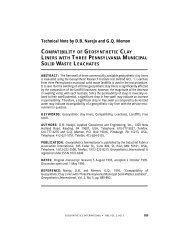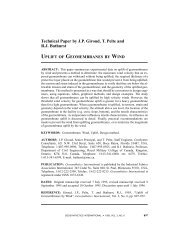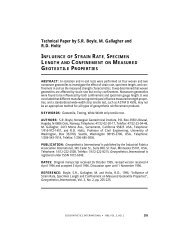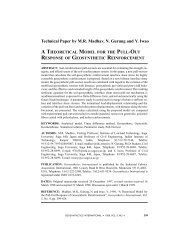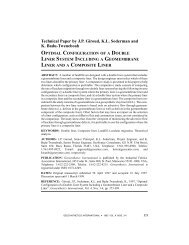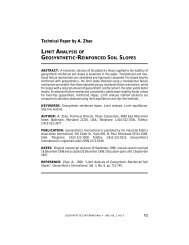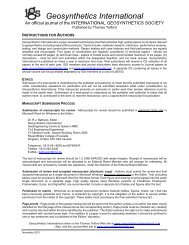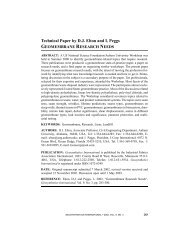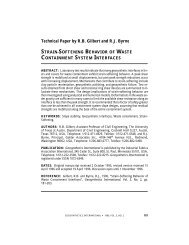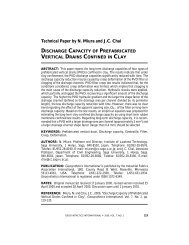leachate flow in leakage collection layers due to defects in ...
leachate flow in leakage collection layers due to defects in ...
leachate flow in leakage collection layers due to defects in ...
Create successful ePaper yourself
Turn your PDF publications into a flip-book with our unique Google optimized e-Paper software.
GIROUD et al. D Leachate Flow <strong>in</strong> Leakage Collection Layers Due <strong>to</strong> Geomembrane Defects<br />
It appears that, when the <strong>leakage</strong> <strong>collection</strong> layer is not full, there is an extremely simple<br />
relationship between the rate of <strong>leachate</strong> migration through the primary l<strong>in</strong>er defect,<br />
Q, and the thickness of <strong>leachate</strong> <strong>in</strong> the <strong>leakage</strong> <strong>collection</strong> layer beneath the defect, t o .<br />
It is <strong>in</strong>terest<strong>in</strong>g <strong>to</strong> note that this relationship does not depend on the size of the defect<br />
<strong>in</strong> the primary l<strong>in</strong>er or on the slope of the <strong>leakage</strong> <strong>collection</strong> layer.<br />
An approximation that was made <strong>to</strong> establish Equations 9 and 10 was <strong>to</strong> assume that<br />
the downslope <strong>flow</strong> l<strong>in</strong>e from A (i.e. AB <strong>in</strong> Figure 4a) is parallel <strong>to</strong> the l<strong>in</strong>er. This assumption<br />
is close <strong>to</strong> reality as discussed <strong>in</strong> Section 2.2. However, the actual <strong>flow</strong> l<strong>in</strong>e<br />
from A is below L<strong>in</strong>e AB as the <strong>flow</strong> thickness decreases <strong>in</strong> the downslope direction,<br />
as discussed at the end of Section 5.1.2. Therefore, t o should only be regarded as the <strong>flow</strong><br />
thickness at a primary l<strong>in</strong>er defect, and it is the maximum <strong>flow</strong> thickness.<br />
S<strong>in</strong>ce the simple relationship expressed by Equations 9 and 10 was demonstrated for<br />
the case when the <strong>leakage</strong> <strong>collection</strong> layer is not full, the condition expressed by Equation<br />
1 must be met for Equations 9 and 10 <strong>to</strong> be valid. Comb<strong>in</strong><strong>in</strong>g Equations 1 and 10<br />
gives the follow<strong>in</strong>g equation, which is another way <strong>to</strong> express the condition that should<br />
be met <strong>to</strong> ensure that the <strong>leakage</strong> <strong>collection</strong> layer is not full:<br />
t<br />
LCL<br />
≥ t =<br />
LCL full<br />
where t LCLfull is the m<strong>in</strong>imum thickness that a <strong>leakage</strong> <strong>collection</strong> layer with a hydraulic<br />
conductivity k should have <strong>to</strong> conta<strong>in</strong>, without be<strong>in</strong>g full at any location, the <strong>leachate</strong><br />
<strong>flow</strong> which results from a defect <strong>in</strong> the primary l<strong>in</strong>er.<br />
The follow<strong>in</strong>g equation, derived from Equation 11, is another way <strong>to</strong> express the condition<br />
that should be met <strong>to</strong> ensure that the <strong>leakage</strong> <strong>collection</strong> layer is not full:<br />
Q ≤ Q = kt<br />
full<br />
where Q full is the maximum steady-state rate of <strong>leachate</strong> migration through a defect <strong>in</strong><br />
the primary l<strong>in</strong>er that a <strong>leakage</strong> <strong>collection</strong> layer, with a thickness t LCL and a hydraulic<br />
conductivity k, can accommodate without be<strong>in</strong>g filled with <strong>leachate</strong>.<br />
It is important <strong>to</strong> remember that the subscript full corresponds <strong>to</strong> a m<strong>in</strong>imum thickness<br />
of the <strong>leakage</strong> <strong>collection</strong> layer and <strong>to</strong> a maximum rate of <strong>leachate</strong> migration (which is<br />
also the maximum <strong>flow</strong> rate <strong>in</strong> the <strong>leakage</strong> <strong>collection</strong> layer). It is noteworthy that the<br />
m<strong>in</strong>imum thickness of the <strong>leakage</strong> <strong>collection</strong> layer, t LCLfull , and the maximum <strong>flow</strong> rate,<br />
Q full , which are required <strong>to</strong> ensure that the <strong>leakage</strong> <strong>collection</strong> layer can conta<strong>in</strong>, without<br />
be<strong>in</strong>g full, the <strong>flow</strong> that results from a defect <strong>in</strong> the primary l<strong>in</strong>er, do not depend on the<br />
slope of the <strong>leakage</strong> <strong>collection</strong> layer.<br />
It is not impossible <strong>to</strong> design a <strong>leakage</strong> <strong>collection</strong> layer with a thickness less than the<br />
value t LCLfull given by Equation 11, i.e. where the <strong>flow</strong> rate is greater than Q full def<strong>in</strong>ed<br />
by Equation 12. In this case, the <strong>leakage</strong> <strong>collection</strong> layer is filled with <strong>leachate</strong> <strong>in</strong> a certa<strong>in</strong><br />
area around the defect of the primary l<strong>in</strong>er (i.e. “the <strong>leachate</strong> <strong>collection</strong> layer is<br />
full”). This case is discussed <strong>in</strong> Section 3.2.<br />
2<br />
LCL<br />
Q<br />
k<br />
(11)<br />
(12)<br />
224 GEOSYNTHETICS INTERNATIONAL S 1997, VOL. 4, NOS. 3-4



